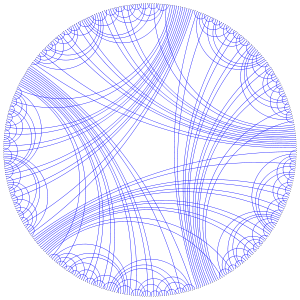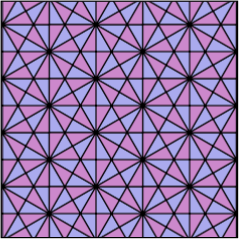Arrangement of lines

In geometry an arrangement of lines is the partition of the plane formed by a collection of lines. Bounds on the complexity of arrangements have been studied in discrete geometry, and computational geometers have found algorithms for the efficient construction of arrangements.
Definition
For any set A of lines in the Euclidean plane, one can define an equivalence relation on the points of the plane according to which two points p and q are equivalent if, for every line l of A, either p and q are both on l or both belong to the same open half-plane bounded by l. When A is finite or locally finite[1] the equivalence classes of this relation are of three types:
- the interiors of bounded or unbounded convex polygons (the cells of the arrangement), the connected components of the subset of the plane not contained in any of the lines of A,
- open line segments and open infinite rays (the edges of the arrangement), the connected components of the points of a single line that do not belong to any other lines of A, and
- single points (the vertices of the arrangement), the intersections of two or more lines of A.
These three types of objects link together to form a cell complex covering the plane. Two arrangements are said to be isomorphic or combinatorially equivalent if there is a one-to-one adjacency-preserving correspondence between the objects in their associated cell complexes.[2]
Complexity of arrangements
The study of arrangements was begun by Jakob Steiner, who proved the first bounds on the maximum number of features of different types that an arrangement may have.[3] An arrangement with n lines has at most n(n − 1)/2 vertices, one per pair of crossing lines. This maximum is achieved for simple arrangements, those in which each two lines has a distinct pair of crossing points. In any arrangement there will be n infinite-downward rays, one per line; these rays separate n + 1 cells of the arrangement that are unbounded in the downward direction. The remaining cells all have a unique bottommost vertex,[4] and each vertex is bottommost for a unique cell, so the number of cells in an arrangement is the number of vertices plus n + 1, or at most n(n + 1)/2 + 1; see lazy caterer's sequence. The number of edges of the arrangement is at most n2, as may be seen either by using the Euler characteristic to calculate it from the numbers of vertices and cells, or by observing that each line is partitioned into at most n edges by the other n − 1 lines; again, this worst-case bound is achieved for simple arrangements.
The zone of a line l in a line arrangement is the collection of cells having edges belonging to l. The zone theorem states that the total number of edges in the cells of a single zone is linear. More precisely, the total number of edges of the cells belonging to a single side of line l is at most 5n − 1,[5] and the total number of edges of the cells belonging to both sides of l is at most .[6] More generally, the total complexity of the cells of a line arrangement that are intersected by any convex curve is O(n α(n)), where α denotes the inverse Ackermann function, as may be shown using Davenport–Schinzel sequences.[6] Summing the complexities of all zones, one finds that the sum of squares of cell complexities in an arrangement is O(n2).[7]
The k-level of an arrangement is the polygonal chain formed by the edges that have exactly k other lines directly below them, and the ≤k-level is the portion of the arrangement below the k-level. Finding matching upper and lower bounds for the complexity of a k-level remains a major open problem in discrete geometry; the best upper bound is O(nk1/3), while the best lower bound is Ω(n exp(c (logk)1/2)).[8] In contrast, the maximum complexity of the ≤k-level is known to be Θ(nk).[9] A k-level is a special case of a monotone path in an arrangement; that is, a sequence of edges that intersects any vertical line in a single point. However, monotone paths may be much more complicated than k-levels: there exist arrangements and monotone paths in these arrangements where the number of points at which the path changes direction is Ω(n2 − o(1)).[10]
Although a single cell in an arrangement may be bounded by all n lines, it is not possible in general for m different cells to all be bounded by n lines. Rather, the total complexity of m cells is at most Θ(m2/3n2/3 + n),[11] almost the same bound as occurs in the Szemerédi–Trotter theorem on point-line incidences in the plane. A simple proof of this follows from the crossing number inequality:[12] if m cells have a total of x + n edges, one can form a graph with m nodes (one per cell) and x edges (one per pair of consecutive cells on the same line). The edges of this graph can be drawn as curves that do not cross within the cells corresponding to their endpoints, and then follow the lines of the arrangement; therefore, there are O(n2) crossings in this drawing. However, by the crossing number inequality, there are Ω(x3/m2) crossings; in order to satisfy both bounds, x must be O(m2/3n2/3).[13]
Projective arrangements and projective duality
It is often convenient to study line arrangements not in the Euclidean plane but in the projective plane, due to the fact that in projective geometry every pair of lines has a crossing point. In the projective plane, we may no longer define arrangements using sides of lines (a line in the projective plane does not separate the plane into two distinct sides), but we may still define the cells of an arrangement to be the connected components of the points not belonging to any line, the edges to be the connected components of sets of points belonging to a single line, and the vertices to be points where two or more lines cross. A line arrangement in the projective plane differs from its Euclidean counterpart in that the two Euclidean rays at either end of a line are replaced by a single edge in the projective plane that connects the leftmost and rightmost vertices on that line, and in that pairs of unbounded Euclidean cells are replaced in the projective plane by single cells that are crossed by the projective line at infinity.
Due to projective duality, many statements about the combinatorial properties of points in the plane may be more easily understood in an equivalent dual form about arrangements of lines. For instance, the Sylvester–Gallai theorem, stating that any non-collinear set of points in the plane has an ordinary line containing exactly two points, transforms under projective duality to the statement that any arrangement of lines with more than one vertex has an ordinary point, a vertex where only two lines cross. The earliest known proof of the Sylvester–Gallai theorem, by Melchior (1940), uses the Euler characteristic to show that such a vertex must always exist.
Triangles in arrangements

An arrangement of lines in the projective plane is said to be simplicial if every cell of the arrangement is bounded by exactly three edges; simplicial arrangements were first studied by Melchior.[14] Three infinite families of simplicial line arrangements are known:
- A near-pencil consisting of n − 1 lines through a single point, together with a single additional line that does not go through the same point,
- The family of lines formed by the sides of a regular polygon together with its axes of symmetry, and
- The sides and axes of symmetry of an even regular polygon, together with the line at infinity.
Additionally there are many other examples of sporadic simplicial arrangements that do not fit into any known infinite family.[15] As Grünbaum[16] writes, simplicial arrangements “appear as examples or counterexamples in many contexts of combinatorial geometry and its applications.” For instance, Artés, Grünbaum & Llibre (1998) use simplicial arrangements to construct counterexamples to a conjecture on the relation between the degree of a set of differential equations and the number of invariant lines the equations may have. The two known counterexamples to the Dirac-Motzkin conjecture (which states that any n-line arrangement has at least n/2 ordinary points) are both simplicial.[17]
The dual graph of a line arrangement, in which there is one node per cell and one edge linking any pair of cells that share an edge of the arrangement, is a partial cube, a graph in which the nodes can be labeled by bitvectors in such a way that the graph distance equals the Hamming distance between labels; in the case of a line arrangement, each coordinate of the labeling assigns 0 to nodes on one side of one of the lines and 1 to nodes on the other side.[18] Dual graphs of simplicial arrangements have been used to construct infinite families of 3-regular partial cubes, isomorphic to the graphs of simple zonohedra.[19]
It is also of interest to study the extremal numbers of triangular cells in arrangements that may not necessarily be simplicial. In any arrangement, there must be at least n triangles; every arrangement that has only n triangles must be simple.[20] The maximum possible number of triangles in a simple arrangement is known to be upper bounded by n(n − 1)/3 and lower bounded by n(n − 3)/3; the lower bound is achieved by certain subsets of the diagonals of a regular 2n-gon.[21] For non-simple arrangements the maximum number of triangles is similar but more tightly bounded.[22] The closely related Kobon triangle problem asks for the maximum number of non-overlapping finite triangles (not necessarily faces) in an arrangement in the Euclidean plane; for some but not all values of n, n(n − 2)/3 triangles are possible.
Multigrids and Penrose tilings
The dual graph of a simple line arrangement may be represented geometrically as a collection of rhombi, one per vertex of the arrangement, with sides perpendicular to the lines that meet at that vertex. These rhombi may be joined together to form a tiling of a convex polygon in the case of an arrangement of finitely many lines, or of the entire plane in the case of a locally finite arrangement with infinitely many lines. de Bruijn (1981) investigated special cases of this construction in which the line arrangement consists of k sets of equally spaced parallel lines. For two perpendicular families of parallel lines this construction just gives the familiar square tiling of the plane, and for three families of lines at 120-degree angles from each other (themselves forming a trihexagonal tiling) this produces the rhombille tiling. However, for more families of lines this construction produces aperiodic tilings. In particular, for five families of lines at equal angles to each other (or, as de Bruijn calls this arrangement, a pentagrid) it produces a family of tilings that include the rhombic version of the Penrose tilings.
The tetrakis square tiling is an infinite arrangement of lines forming a periodic tiling that resembles a multigrid with four parallel families, but in which two of the families are more widely spaced than the other two, and in which the arrangement is simplicial rather than simple. Its dual is the truncated square tiling. Similarly, the triangular tiling is an infinite simplicial line arrangement with three parallel families, which has as its dual the hexagonal tiling, and the bisected hexagonal tiling is an infinite simplicial line arrangement with six parallel families and two line spacings, dual to the great rhombitrihexagonal tiling.
Algorithms
Constructing an arrangement means, given as input a list of the lines in the arrangement, computing a representation of the vertices, edges, and cells of the arrangement together with the adjacencies between these objects, for instance as a doubly connected edge list. Due to the zone theorem, arrangements can be constructed efficiently by an incremental algorithm that adds one line at a time to the arrangement of the previously added lines: each new line can be added in time proportional to its zone, resulting in a total construction time of O(n2).[5] However, the memory requirements of this algorithm are high, so it may be more convenient to report all features of an arrangement by an algorithm that does not keep the entire arrangement in memory at once. This may again be done efficiently, in time O(n2) and space O(n), by an algorithmic technique known as topological sweeping.[23] Computing a line arrangement exactly requires a numerical precision several times greater than that of the input coordinates: if a line is specified by two points on it, the coordinates of the arrangement vertices may need four times as much precision as these input points. Therefore, computational geometers have also studied algorithms for constructing arrangements efficiently with limited numerical precision.[24]
As well, researchers have studied efficient algorithms for constructing smaller portions of an arrangement, such as zones,[25] k-levels,[26] or the set of cells containing a given set of points.[27] The problem of finding the arrangement vertex with the median x-coordinate arises (in a dual form) in robust statistics as the problem of computing the Theil–Sen estimator of a set of points.[28]
Marc van Kreveld suggested the algorithmic problem of computing shortest paths between vertices in a line arrangement, where the paths are restricted to follow the edges of the arrangement, more quickly than the quadratic time that it would take to apply a shortest path algorithm to the whole arrangement graph.[29] An approximation algorithm is known,[30] and the problem may be solved efficiently for lines that fall into a small number of parallel families (as is typical for urban street grids),[31] but the general problem remains open.
Non-Euclidean line arrangements


A pseudoline arrangement is a family of curves that share similar topological properties with a line arrangement.[32] These can be defined most simply in the projective plane as simple closed curves any two of which meet in a single crossing point.[33] A pseudoline arrangement is said to be stretchable if it is combinatorially equivalent to a line arrangement; it is complete for the existential theory of the reals to distinguish stretchable arrangements from non-stretchable ones.[34] Every arrangement of finitely many pseudolines can be extended so that they become lines in a "spread", a type of non-Euclidean incidence geometry in which every two points of a topological plane are connected by a unique line (as in the Euclidean plane) but in which other axioms of Euclidean geometry may not apply.
Another type of non-Euclidean geometry is the hyperbolic plane, and arrangements of hyperbolic lines in this geometry have also been studied. Any finite set of lines in the Euclidean plane has a combinatorially equivalent arrangement in the hyperbolic plane (e.g. by enclosing the vertices of the arrangement by a large circle and interpreting the interior of the circle as a Klein model of the hyperbolic plane). However, in hyperbolic line arrangements lines may avoid crossing each other without being parallel; the intersection graph of the lines in a hyperbolic arrangement is a circle graph. The corresponding concept to hyperbolic line arrangements for pseudolines is a weak pseudoline arrangement,[35] a family of curves having the same topological properties as lines[36] such that any two curves in the family either meet in a single crossing point or have no intersection.
See also
- Configuration (geometry), an arrangement of lines and a set of points with all lines containing the same number of points and all points belonging to the same number of lines.
- Arrangement (space partition), a partition of the plane given by overlaid curves or of a higher dimensional space by overlaid surfaces, without requiring the curves or surfaces to be flat
Notes
- ↑ For an arrangement to be locally finite, every bounded subset of the plane may be crossed by only finitely many lines.
- ↑ Grünbaum (1972), page 4.
- ↑ Steiner (1826); Agarwal & Sharir (2000).
- ↑ For cells in which there is a horizontal bottom edge, choose the bottommost vertex to be the right endpoint of the bottom edge.
- 1 2 Chazelle, Guibas & Lee (1985), Edelsbrunner (1987), Edelsbrunner, O'Rourke & Seidel (1986).
- 1 2 Bern et al. (1991).
- ↑ Aronov, Matoušek & Sharir (1994).
- ↑ Dey (1998); Tóth (2001). The problem of bounding the complexity of k-levels was first studied by Lovász (1971) and Erdős et al. (1973).
- ↑ Alon & Győri (1986).
- ↑ Balogh et al. (2004); see also Matoušek (1991).
- ↑ Canham (1969); Clarkson et al. (1990).
- ↑ Ajtai et al. (1982); Leighton (1983).
- ↑ Székely (1997).
- ↑ Melchior (1940); Grünbaum (2005).
- ↑ Grünbaum (1972); Grünbaum (2005).
- ↑ Grünbaum (2005)
- ↑ Crowe & McKee (1968); Dirac (1951); Kelly & Moser (1958); Grünbaum (1972), page 18.
- ↑ Eppstein, Falmagne & Ovchinnikov (2007).
- ↑ Eppstein (2006).
- ↑ Grünbaum (1972); Levi (1926); Roudneff (1988).
- ↑ Füredi & Palásti (1984); Grünbaum (1972).
- ↑ Purdy (1979); Purdy (1980); Strommer (1977).
- ↑ Edelsbrunner & Guibas (1989).
- ↑ Fortune & Milenkovic (1991); Greene & Yao (1986); Milenkovic (1989).
- ↑ Aharoni et al. (1999).
- ↑ Agarwal et al. (1998); Chan (1999); Cole, Sharir & Yap (1987); Edelsbrunner & Welzl (1986).
- ↑ Agarwal (1990); Agarwal, Matoušek & Sharir (1998); Edelsbrunner, Guibas & Sharir (1990).
- ↑ Cole et al. (1989).
- ↑ Erickson (1997).
- ↑ Bose et al. (1996).
- ↑ Eppstein & Hart (1999).
- ↑ Grünbaum (1972); Agarwal & Sharir (2002).
- ↑ This definition is from Grünbaum (1972). For a comparison of alternative definitions of pseudolines, see Eppstein, Falmagne & Ovchinnikov (2007).
- ↑ Shor (1991); Schaefer (2010).
- ↑ de Fraysseix & Ossona de Mendez (2003).
- ↑ Here an alternative definition from Shor (1991), that a pseudoline is the image of a line under a homeomorphism of the plane, is appropriate.
References
- Agarwal, P. K. (1990), "Partitioning arrangements of lines II: Applications", Discrete and Computational Geometry, 5 (1): 533–573, doi:10.1007/BF02187809.
- Agarwal, P. K.; de Berg, M.; Matoušek, J.; Schwarzkopf, O. (1998), "Constructing levels in arrangements and higher order Voronoi diagrams", SIAM Journal on Computing, 27 (3): 654–667, doi:10.1137/S0097539795281840.
- Agarwal, P. K.; Matoušek, J.; Sharir, M. (1998), "Computing many faces in arrangements of lines and segments", SIAM Journal on Computing, 27 (2): 491–505, doi:10.1137/S009753979426616X.
- Agarwal, P. K.; Sharir, M. (2000), "Arrangements and their applications", in Sack, J.-R.; Urrutia, J., Handbook of Computational Geometry, Elsevier, pp. 49–119.
- Agarwal, P. K.; Sharir, M. (2002), "Pseudo-line arrangements: duality, algorithms, and applications", Proc. 13th ACM-SIAM Symp. Discrete algorithms (SODA '02), San Francisco: Society for Industrial and Applied Mathematics, pp. 800–809.
- Ageev, A. A. (1996), "A triangle-free circle graph with chromatic number 5", Discrete Math., 152: 295–298, doi:10.1016/0012-365X(95)00349-2.
- Aharoni, Y.; Halperin, D.; Hanniel, I.; Har-Peled, S.; Linhart, C. (1999), "On-line zone construction in arrangements of lines in the plane", Proc. 3rd Int. Worksh. Algorithm Engineering (WAE '99), Lecture Notes in Computer Science, 1668, Springer-Verlag, pp. 139–153, doi:10.1007/3-540-48318-7_13.
- Ajtai, M.; Chvátal, V.; Newborn, M.; Szemerédi, E. (1982), "Crossing-free subgraphs", Theory and Practice of Combinatorics, North-Holland Mathematics Studies, 60, North-Holland, pp. 9–12, MR 0806962.
- Alon, N.; Győri, E. (1986), "The number of small semi-spaces of a finite set of points in the plane", Journal of Combinatorial Theory, Series A, 41: 154–157, doi:10.1016/0097-3165(86)90122-6.
- Aronov, B.; Matoušek, J.; Sharir, M. (1994), "On the sum of squares of cell complexities in hyperplane arrangements", Journal of Combinatorial Theory, Series A, 65 (2): 311–321, doi:10.1016/0097-3165(94)90027-2
- Artés, J. C.; Grünbaum, B.; Llibre, J. (1998), "On the number of invariant straight lines for polynomial differential systems" (PDF), Pacific Journal of Mathematics, 184 (2): 207–230, doi:10.2140/pjm.1998.184.207.
- Balogh, J.; Regev, O.; Smyth, C.; Steiger, W.; Szegedy, M. (2004), "Long monotone paths in line arrangements", Discrete and Computational Geometry, 32 (2): 167–176, doi:10.1007/s00454-004-1119-1.
- Bern, M. W.; Eppstein, D.; Plassman, P. E.; Yao, F. F. (1991), "Horizon theorems for lines and polygons", in Goodman, J. E.; Pollack, R.; Steiger, W., Discrete and Computational Geometry: Papers from the DIMACS Special Year, DIMACS Ser. Discrete Math. and Theoretical Computer Science (6 ed.), Amer. Math. Soc., pp. 45–66, MR 92j:52023.
- Bose, P.; Evans, W.; Kirkpatrick, D. G.; McAllister, M.; Snoeyink, J. (1996), "Approximating shortest paths in arrangements of lines", Proc. 8th Canadian Conf. Computational Geometry, pp. 143–148.
- de Bruijn, N. G. (1981), "Algebraic theory of Penrose's non-periodic tilings of the plane" (PDF), Indagationes Mathematicae, 43: 38–66.
- Canham, R. (1969), "A theorem on arrangements of lines in the plane", Israel J. Math., 7 (4): 393–397, doi:10.1007/BF02788872.
- Chan, T. (1999), Remarks on k-level algorithms in the plane.
- Chazelle, B.; Guibas, L. J.; Lee, D. T. (1985), "The power of geometric duality", BIT, 25 (1): 76–90, doi:10.1007/BF01934990.
- Clarkson, K.; Edelsbrunner, H.; Guibas, L. J.; Sharir, M.; Welzl, E. (1990), "Combinatorial complexity bounds for arrangements of curves and spheres", Discrete and Computational Geometry, 5 (1): 99–160, doi:10.1007/BF02187783.
- Cole, Richard; Salowe, Jeffrey S.; Steiger, W. L.; Szemerédi, Endre (1989), "An optimal-time algorithm for slope selection", SIAM Journal on Computing, 18 (4): 792–810, doi:10.1137/0218055, MR 1004799.
- Cole, R.; Sharir, M.; Yap, C.-K. (1987), "On k-hulls and related problems", SIAM Journal on Computing, 16 (1): 61–77, doi:10.1137/0216005.
- Crowe, D. W.; McKee, T. A. (1968), "Sylvester's problem on collinear points", Mathematics Magazine, Mathematical Association of America, 41 (1): 30–34, doi:10.2307/2687957, JSTOR 2687957.
- Dey, T. L. (1998), "Improved bounds for planar k-sets and related problems", Discrete and Computational Geometry, 19 (3): 373–382, doi:10.1007/PL00009354, MR 1608878.
- Dirac, G. (1951), "Collinearity properties of sets of points", Quart. J. Math., 2: 221–227, doi:10.1093/qmath/2.1.221.
- Edelsbrunner, H. (1987), Algorithms in Combinatorial Geometry, EATCS Monographs in Theoretical Computer Science, Springer-Verlag, ISBN 978-3-540-13722-1.
- Edelsbrunner, H.; Guibas, L. J. (1989), "Topologically sweeping an arrangement", Journal of Computer and System Sciences, 38 (1): 165–194, doi:10.1016/0022-0000(89)90038-X.
- Edelsbrunner, H.; Guibas, L. J.; Sharir, M. (1990), "The complexity and construction of many faces in arrangements of lines and of segments", Discrete and Computational Geometry, 5 (1): 161–196, doi:10.1007/BF02187784.
- Edelsbrunner, H.; O'Rourke, J.; Seidel, R. (1986), "Constructing arrangements of lines and hyperplanes with applications", SIAM Journal on Computing, 15 (2): 341–363, doi:10.1137/0215024.
- Edelsbrunner, H.; Welzl, E. (1986), "Constructing belts in two-dimensional arrangements with applications", SIAM Journal on Computing, 15 (1): 271–284, doi:10.1137/0215019.
- Eppstein, D. (2006), "Cubic partial cubes from simplicial arrangements", Electronic J. Combinatorics, 13 (1, R79): 1–14, arXiv:math.CO/0510263
 , MR 2255421.
, MR 2255421. - Eppstein, D.; Falmagne, J.-Cl.; Ovchinnikov, S. (2007), Media Theory, Springer-Verlag.
- Eppstein, D.; Hart, D. (1999), "Shortest paths in an arrangement with k line orientations", Proc. 10th ACM/SIAM Symp. Discrete Algorithms (SODA '99), pp. 310–316.
- Erdős, P.; Lovász, L.; Simmons, A.; Straus, E. G. (1973), "Dissection graphs of planar point sets", A Survey of Combinatorial Theory (Proc. Internat. Sympos., Colorado State Univ., Fort Collins, Colo., 1971), Amsterdam: North-Holland, pp. 139–149, MR 0363986.
- Erickson, J. (1997), Shortest paths in line arrangements.
- Fortune, S.; Milenkovic, V. (1991), "Numerical stability of algorithms for line arrangements", Proc. 7th ACM Symp. Computational Geometry (SoCG '91), pp. 334–341, doi:10.1145/109648.109685.
- de Fraysseix, H.; Ossona de Mendez, P. (2003), "Stretching of Jordan arc contact systems", Proc. 11th Int. Symp. Graph Drawing (GD 2003), Lecture Notes in Computer Science (2912 ed.), Springer-Verlag, pp. 71–85.
- Füredi, Z.; Palásti, I. (1984), "Arrangements of lines with a large number of triangles" (PDF), Proceedings of the American Mathematical Society, 92 (4): 561–566, doi:10.2307/2045427
- Greene, D.; Yao, F. F. (1986), "Finite-resolution computational geometry", Proc. 27th IEEE Symp. Foundations of Computer Science, pp. 143–152, doi:10.1109/SFCS.1986.19.
- Grünbaum, B. (1972), Arrangements and Spreads, Regional Conference Series in Mathematics, 10, Providence, R.I.: American Mathematical Society.
- Grünbaum, B. (2005), A catalogue of simplicial arrangements in the real projective plane.
- Kelly, L. M.; Moser, W. O. J. (1958), "On the number of ordinary lines determined by n points", Canad. J. Math., 10: 210–219, doi:10.4153/CJM-1958-024-6.
- Leighton, F. T. (1983), Complexity Issues in VLSI, Foundations of Computing Series, Cambridge, MA: MIT Press.
- Levi, F. (1926), "Die Teilung der projektiven Ebene durch Gerade oder Pseudogerade", Ber. Math.-Phys. Kl. Sächs. Akad. Wiss. Leipzig, 78: 256–267.
- Lovász, L. (1971), "On the number of halving lines", Annales Universitatis Scientiarum Budapestinensis de Rolando Eőtvős Nominatae Sectio Mathematica, 14: 107–108.
- Matoušek, J. (1991), "Lower bounds on the length of monotone paths in arrangements", Discrete and Computational Geometry, 6 (1): 129–134, doi:10.1007/BF02574679.
- Melchior, E. (1940), "Über Vielseite der projektiven Ebene", Deutsche Mathematik, 5: 461–475.
- Milenkovic, V. (1989), "Double precision geometry: a general technique for calculating line and segment intersections using rounded arithmetic", Proc. 30th IEEE Symp. Foundations of Computer Science (FOCS '89), pp. 500–505, doi:10.1109/SFCS.1989.63525.
- Motzkin, Th. (1951), "The Lines and Planes Connecting the Points of a Finite Set", Transactions of the American Mathematical Society, American Mathematical Society, 70 (3): 451–464, doi:10.2307/1990609, JSTOR 1990609.
- Purdy, G. B. (1979), "Triangles in arrangements of lines", Discrete Math., 25 (2): 157–163, doi:10.1016/0012-365X(79)90018-9.
- Purdy, G. B. (1980), "Triangles in arrangements of lines, II", Proceedings of the American Mathematical Society, 79: 77–81, doi:10.1090/S0002-9939-1980-0560588-4.
- Roudneff, J.-P. (1988), "Arrangements of lines with a minimum number of triangles are simple", Discrete and Computational Geometry, 3 (1): 97–102, doi:10.1007/BF02187900.
- Schaefer, Marcus (2010), "Complexity of some geometric and topological problems" (PDF), Graph Drawing, 17th International Symposium, GS 2009, Chicago, IL, USA, September 2009, Revised Papers, Lecture Notes in Computer Science, 5849, Springer-Verlag, pp. 334–344, doi:10.1007/978-3-642-11805-0_32.
- Shor, P. W. (1991), "Stretchability of pseudolines is NP-hard", in Gritzmann, P.; Sturmfels, B., Applied Geometry and Discrete Mathematics: The Victor Klee Festschrift, DIMACS Series in Discrete Mathematics and Theoretical Computer Science, 4, Providence, R.I.: American Mathematical Society, pp. 531–554.
- Steiner, J. (1826), "Einige Gesetze über die Theilung der Ebene und des Raumes", J. Reine Angew. Math., 1: 349–364.
- Strommer, T. O. (1977), "Triangles in arrangements of lines", Journal of Combinatorial Theory, Series A, 23 (3): 314–320, doi:10.1016/0097-3165(77)90022-X.
- Székely, L. A. (1997), "Crossing numbers and hard Erdős problems in discrete geometry", Combinatorics, Probability and Computing, 6 (3): 353–358, doi:10.1017/S0963548397002976.
- Tóth, G. (2001), "Point sets with many k-sets", Discrete and Computational Geometry, 26 (2): 187–194, doi:10.1007/s004540010022.

